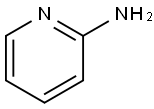2-Aminopyridine , CP , 504-29-0
Synonym(s):
o-Aminopyridine;2-Aminopyridine;2-AP;2-Pyridinamine;2-Pyridylamine
CAS NO.:504-29-0
Empirical Formula: C5H6N2
Molecular Weight: 94.11
MDL number: MFCD00006312
EINECS: 207-988-4
PRODUCT Properties
| Melting point: | 59 °C |
| Boiling point: | 204-210 °C(lit.) |
| bulk density | 600kg/m3 |
| Density | 1.0308 (estimate) |
| vapor pressure | 5 hPa (125 °C) |
| refractive index | 1.5560 (estimate) |
| Flash point: | 198 °F |
| storage temp. | Store below +30°C. |
| solubility | 890g/l |
| pka | 6.82(at 20℃) |
| form | Crystalline Powder, Crystals or Flakes |
| color | Cream to light yellow-beige |
| Odor | Characteristic odour |
| Water Solubility | Slightly soluble. 1-5 g/100 mL at 19 ºC |
| Sensitive | Hygroscopic |
| Merck | 14,473 |
| BRN | 105785 |
| Exposure limits | NIOSH REL: TWA 0.5 ppm (2 mg/m3), IDLH 5 ppm; OSHA PEL: 0.5 ppm;
ACGIH TLV: TWA 0.5 ppm. |
| LogP | 0.53 |
| CAS DataBase Reference | 504-29-0(CAS DataBase Reference) |
| NIST Chemistry Reference | 2-Pyridinamine(504-29-0) |
| EPA Substance Registry System | 2-Aminopyridine (504-29-0) |
Description and Uses
2-Aminopyridine is used primarily in the pharmaceutical industry as an intermediate in chemical synthesis. It is used to manufacturing analgesic and anti-inflammatory drugs piroxicam and lornoxicam. 2-Aminopyridine is a basic building block of several heterocyclic compounds and Schiff bases. It has been shown to reversibly block voltage-dependent potassium channels, and is also a common impurity from the synthesis of compounds found in hair dyes. It is a derivatizing agent which can be used as a fluorescent label for oligosaccharide detection, chromatographic separation, fluorometric or mass spectrometric analysis. 2AP and its derivatives are good candidates for antimicrobial, anticorrosion and molecular sensing applications.
Safety
| Symbol(GHS) |   GHS05,GHS06 |
| Signal word | Danger |
| Hazard statements | H301+H311-H314-H412 |
| Precautionary statements | P260-P273-P280-P303+P361+P353-P304+P340+P310-P305+P351+P338 |
| Hazard Codes | T,Xi |
| Risk Statements | 21-25-36/37/38-23/24/25 |
| Safety Statements | 26-36/37/39-45-38-28B |
| RIDADR | UN 2671 6.1/PG 2 |
| OEB | B |
| OEL | TWA: 0.5 ppm (2 mg/m3) |
| WGK Germany | 3 |
| RTECS | US1575000 |
| F | 8-21 |
| Autoignition Temperature | >630 °C |
| Hazard Note | Toxic/Irritant |
| TSCA | Yes |
| HazardClass | 6.1 |
| PackingGroup | II |
| HS Code | 29333999 |
| Hazardous Substances Data | 504-29-0(Hazardous Substances Data) |
| Toxicity | LD50 orally in Rabbit: 200 mg/kg |
| IDLA | 5 ppm |
| Limited Quantities | 100ml (liquid) or 0.5 Kg (solid) |
| Excepted Quantities | Max Inner Pack (1g or 1ml) and Max Outer Pack (500g or 500ml) |


